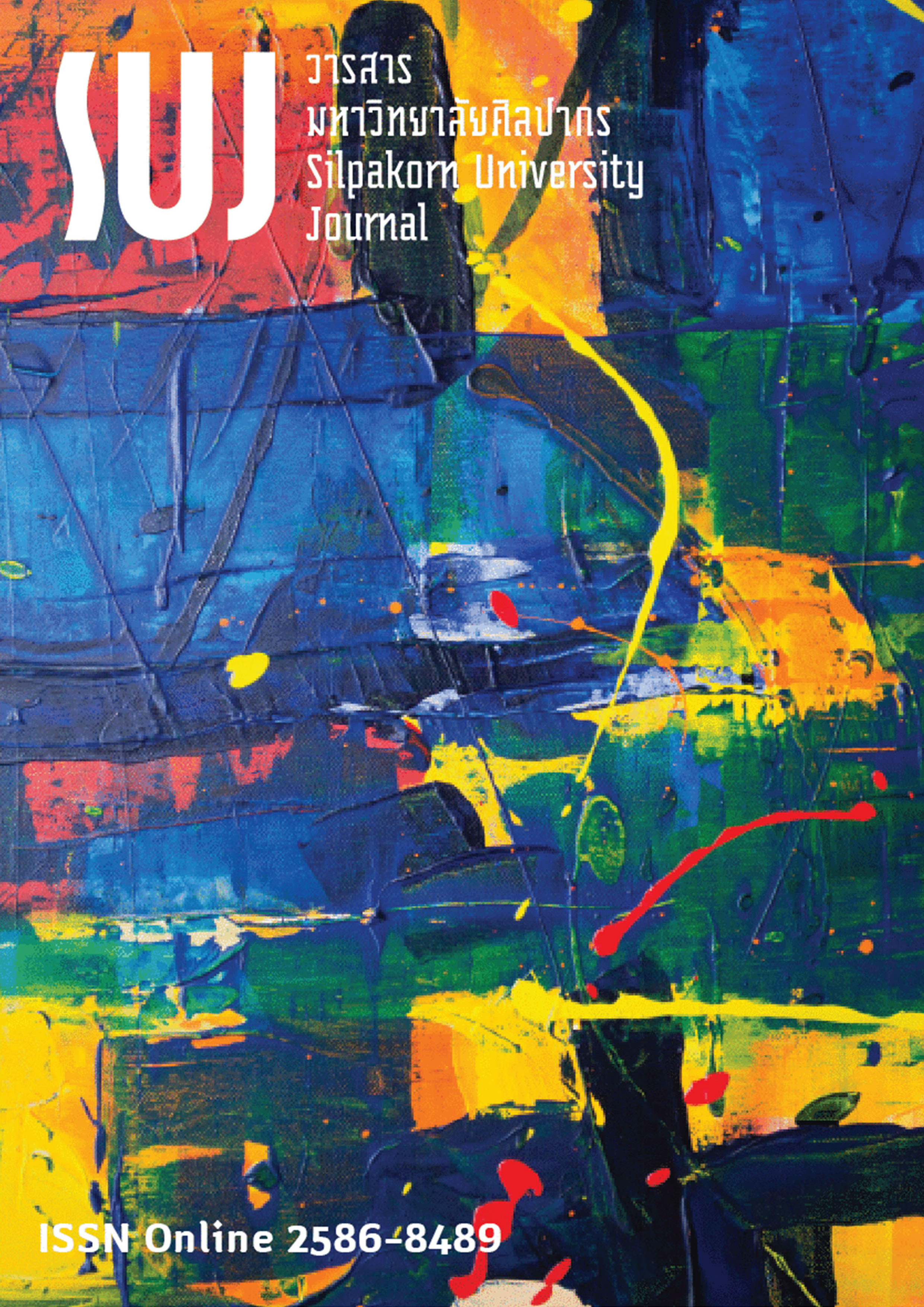การพัฒนาหลักสูตรผ้าทอกี่คำบ้านน้ำหลง อำเภอสบปราบ จังหวัดลำปาง (The development of the “Gee-Kham” handweaving curriculum at Ban Nam Long, Sop Prap District, Lampang Province)
Main Article Content
Abstract
การวิจัยในครั้งนี้มีวัตถุประสงค์เพื่อ 1) สร้างและหาคุณภาพหลักสูตรผ้าทอกี่คำบ้านน้ำหลง อำเภอสบปราบ จังหวัดลำปาง 2) ศึกษาผลการใช้หลักสูตรผ้าทอกี่คำบ้านน้ำหลง อำเภอสบปราบ จังหวัดลำปาง กลุ่มตัวอย่างที่ใช้ในการวิจัย ได้แก่ นักเรียนชั้นมัธยมศึกษาปีที่ 1-3 โรงเรียนชุมชนบ้านจัววิทยา อำเภอสบปราบ จังหวัดลำปาง จำนวน 41 คน คัดเลือกโดยวิธีการสุ่มอย่างง่าย (simple random sampling) เครื่องมือที่ใช้ในการวิจัย ได้แก่ 1) หลักสูตร 2) เอกสารประกอบหลักสูตร 3) แบบทดสอบวัดผลสัมฤทธิ์ทางการเรียน เรื่อง ผ้าทอกี่คำบ้านน้ำหลง และ 4) แบบวัดความสามารถในการออกแบบสื่อวีดิทัศน์ประชาสัมพันธ์ผลิตภัณฑ์ผ้าทอกี่คำบ้านน้ำหลง ทำการวิเคราะห์ข้อมูลโดยหาค่าร้อยละ ค่าเฉลี่ย ส่วนเบี่ยงเบนมาตรฐาน และ t-test ซึ่งผลการวิจัย พบว่า 1) การสร้างและคุณภาพของหลักสูตร มีค่าเฉลี่ยความเหมาะสมของหลักสูตร อยู่ในระดับมากที่สุด และเอกสารประกอบหลักสูตร มีค่าเฉลี่ยความเหมาะสมของเอกสารประกอบหลักสูตร อยู่ในระดับมากที่สุด และ 2) การศึกษาผลการใช้หลักสูตร นักเรียนชั้นมัธยมศึกษาปีที่ 1-3 ที่ผ่านการเรียนรู้ตามหลักสูตร มีคะแนนหลังการทดลองสูงกว่าก่อนการทดลองอย่างมีนัยสำคัญทางสถิติ ซึ่งเป็นไปตามสมมุติฐานที่ตั้งไว้ และผลการวัดความสามารถในการออกแบบสื่อวีดิทัศน์ประชาสัมพันธ์ผลิตภัณฑ์ผ้าทอกี่คำบ้านน้ำหลงของนักเรียนภาพรวมอยู่ในระดับมาก โดยผลการวิจัยครั้งนี้ นำไปสู่แนวทางการพัฒนาหลักสูตรระดับท้องถิ่นในสถานศึกษาให้สอดคล้องกับความต้องการของท้องถิ่นและสามารถนำมาจัดการเรียนการสอนในชั้นเรียน รวมทั้งส่งเสริมเยาวชนในการอนุรักษ์และสืบสานภูมิปัญญาท้องถิ่น โดยมุ่งให้เยาวชนมีบทบาทและมีส่วนร่วมในการถ่ายทอดภูมิปัญญาท้องถิ่นสืบไป
The objectives of this research are as follows: 1) to create and determine the quality of the “Gee-Kham” handweaving curriculum at Ban Nam Long, Sop Prap District, Lampang Province, and 2) to examine the results of using the weaving curriculum at Ban Nam Long, Sop Prap District, Lampang Province. The sample group comprised 41 students from Matthayom 1-3 at Chumchonbanjuawittaya School, Sop Prap District, Lampang Province, selected through simple random sampling. The research instruments used included: 1) Curriculum, 2) Supplementary handouts, 3) Test measuring learning achievement on “Gee-Kham” handweaving at Ban Nam Long, and 4) Assessment of ability in designing audiovisual communication media for promoting Ban Nam Long weaving products. Data were analyzed using percentages, means, standard variations, and t–tests. The research findings indicated that: 1) The development and quality of the curriculum, along with the curriculum and supplementary handouts, achieved the highest level of appropriateness; 2) The study of the results of using the curriculum with students in Matthayom 1-3 who had undergone learning based on the curriculum showed statistically significant higher scores in the post-test compared to the pre-test, aligning with the established hypotheses. Additionally, the design competency of the Gee-Kham handwoven cloth promotional product video was rated at a high level overall. This research contributes to the development of local-level curriculum at educational institutions that aligns with the local context and meets the needs of the community, enabling effective classroom management and promoting youth engagement in preserving and perpetuating local wisdom, thus allowing them to play an active role in passing down local traditions.
Downloads
Article Details

This work is licensed under a Creative Commons Attribution-NonCommercial-NoDerivatives 4.0 International License.
References
Art-in, Sitthipon. (2021). Curriculum Development (การพัฒนาหลักสูตร) (6th ed.). Khon Kaen: Khon Kaen University.
Chaiphakdee, Duanpenporn. (2016). The development of local curriculum for transmitting popular wisdom on the silk (การพัฒนาหลักสูตรท้องถิ่นเพื่อถ่ายทอดภูมิปัญญาทอผ้าไหม). Journal of Research and Development Buriram Rajabhat University, 11(special): 173-182.
Chamnian, Methavee, Chamnian, Korrakot, & Kaewsanit, Mathee. (2021). Local curriculum in terms of communication: Tools for transferring art, Culture and wisdom (หลักสูตรท้องถิ่นในแง่มุมของการสื่อสาร: เครื่องมือการถ่ายทอดศิลปวัฒนธรรมและภูมิปัญญา). Journal of MCU Nakhondhat, 8(4): 48-58.
Cheykeewong, Udom. (2002). Local Curriculum Learning Reform Strategy (หลักสูตรท้องถิ่น : ยุทธศาสตร์การปฏิรูปการเรียนรู้). Bangkok: Bhannakij.
Dachakupt, Pimpan, & Yindeesuk, Payao. (2014). Learning Management in the 21st Century (การจัดการเรียนรู้ในศตวรรษที่ 21). Bangkok: Chulalongkorn University Press.
Kaewurai, Wareerat. (2021). Curriculum Development: from Theory to Practice (การพัฒนาหลักสูตร : จากทฤษฎีสู่การปฏิบัติ). Phitsanulok: Naresuan University Publishing House.
Lowenfeld, V. (1957). Creative and Mental Growth (3rd ed.). New York: The Macmillan Company.
O-isulaya, Niyom. (1995). A Study of Transmission of Thai Song Dum Hand Weaving in Phetchaburi Province (การศึกษาการสืบทอดงานศิลปะผ้าทอของกลุ่มชนไทยทรงดำ ในจังหวัดเพชรบุรี). Master’ s dissertation, Chulalongkorn University, Bangkok, Thailand.
Oliva, P. F. (1992). Developing the Curriculum (3rd ed.). New York: Harper Collins Publishers.
Panich, Vijarn. (2012). Ways to Create Learning for Students in the 21st Century (วิถีสร้างการเรียนรู้เพื่อศิษย์ ในศตวรรษที่ 21) (Lertwijitcharat, Wanna & Treteppratima, Sanguansri, Eds.). Bangkok: Tathata Publication Co., Ltd.
Promata, Sakorn, & Khamawattana, Permkiet. (2016). Synthesis of theses on local curriculum development in Thailand (การสังเคราะห์วิทยานิพนธ์เกี่ยวกับการพัฒนาหลักสูตรท้องถิ่นในประเทศไทย). Journal of Education Studies, 44(2): 183-201.
Punyopashtambha, Hathairat. (2018). Local Wisdom and Development (ภูมิปัญญาท้องถิ่นกับการพัฒนา). Bangkok: Rungreung.
Ra-Ngubtook, Wattanaporn. (2002). Learning Techniques and Activities that Emphasize Student-Centered Learning According to the Basic Education Curriculum, 2001 (เทคนิคและกิจกรรมการเรียนรู้ที่เน้นผู้เรียนเป็นสำคัญตามหลักสูตรการศึกษาขั้นพื้นฐาน พ.ศ. 2544). Bangkok: Prikwan Graphic.
Saylor, J. G., & Alexander, W. M. (1974). Planning Curriculum for Schools. New York: Holt, Rinehart and Wiston.
Taba, H. (1962). Curriculum Development: Theory and Practice. New York: Harcourt Brace & World.
Thatthong, Kanata. (2007). Techniques for School-Based Curriculum Development (เทคนิคการพัฒนาหลักสูตรสถานศึกษา). Nakhon Pathom: Phetkasem Printing.
Thongthew, Samlee. (2002). Principles and Guidelines for School-Based Curriculum: Science Case Elementary School (หลักการและแนวปฏิบัติในการพัฒนาหลักสูตรสถานศึกษา : กรณีวิชาวิทยาศาสตร์ระดับประถมศึกษา). Bangkok: Chulalongkorn University.
Thonthong, Sirimongkol, Pinyoanantapong, Sirima, Pinyoanantapong, Booncherd, & Dechakup, Yaowapa. (2010). The development of curriculum for young children based on local wisdom in Surin Province (การพัฒนาหลักสูตรภูมิปัญญาท้องถิ่นสุรินทร์สำหรับเด็กปฐมวัย). Journal of Education Burapha University, 21(3): 1-12.
U2TSamai. (2021, May 26). Video Clip Introducing Ban Nam Long’s Ki Kham Weaving Products (วิดีโอแนะนำผลิตภัณฑ์ผ้าทอกี่คำบ้านน้ำหลง) [Video clip]. Retrieved from https://www.facebook.com/U2TSamai


